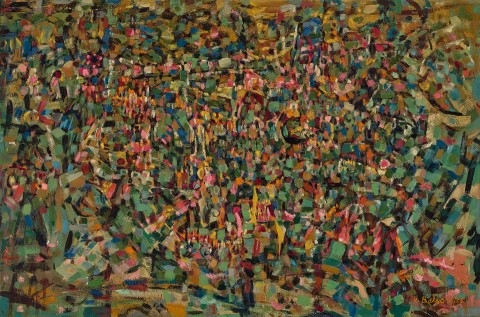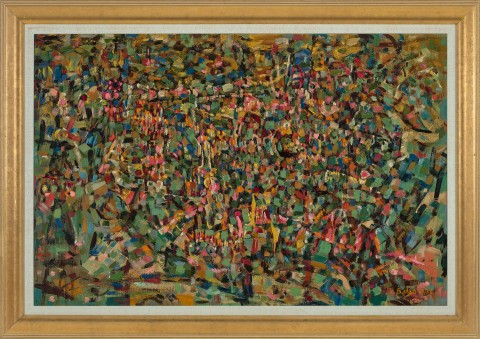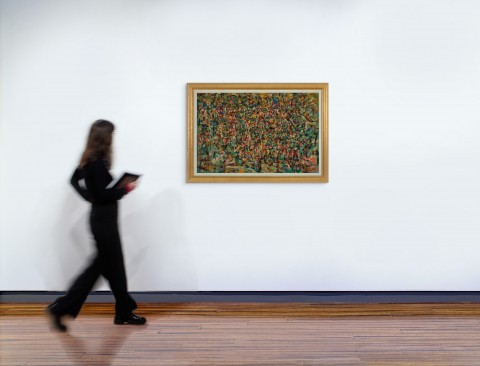NON-OBJECTIVE PAINTING, 1956
RALPH BALSON
oil on composition board
70.5 x 107.0 cm
signed and dated lower right: R. Balson. / 56
bears inscription verso: No 12
The artist's family, Adelaide
Deutscher and Hackett, Melbourne, 29 August 2007, lot 66
Private collection, Melbourne
While we can appreciate Ralph Balson’s virtuosity in isolation from Sydney’s mid-20th century artistic milieu, a fuller story is revealed when we see him at the height amongst a generation of like-minded Australian abstract painters. It remains an enduring achievement in modern Australian art history, an account of Australia internationalising itself, resisting other desires of colloquially observed expression.
Balson’s career is a patchwork of autodidacticism, vast curiosity and connection with those where accommodating convention was at odds with their instincts. Born in Dorset in 1890, he attended the local village school, became apprenticed to a plumber and house painter at age 13. He came to Australia in 1923 and enrolled in weekend classes at the Julian Ashton Art School – Grace Crowley and Anne Dangar were teachers. Crowley and Balson were to become lifelong friends, with the former observing of their diverse artistic journeys, ‘Balson I believe to have been born an abstract painter. He was born that way, while I had to be educated that way.’1
Crowley went to France for five years and studied under Albert Gleizes and André Lhôte, both pursuing a search for an expanded role for Cubism. In 1932 and back in Sydney, Crowley and Rah Fizelle established a School. Balson assisted by painting the premises and studied there. In 1939, he was included in Exhibition 1 at David Jones Gallery, the first exhibition in Australia of artists working with abstraction. And in 1941, Balson exhibited ‘Constructive Paintings' at Anthony Hordern & Sons Gallery – geometric abstractions of interlocking and overlapping planes of colour.
Across all Balson’s paintings there is a beautifully controlled viscous quality where the distinctive hand of the artist is ever-present. The later ‘Non-Objective Paintings’, from the mid-late 1950s, consist of complex fields of orchestrated single-brush strokes, a multipart ensemble becoming a unified whole.
Non-Objective Painting was painted in 1956, the year that Balson, John Olsen, John Passmore, Robert Klippel, Eric Smith and William Rose came together in a group exhibition at Macquarie Galleries, Direction 1. It has been credited as the first Abstract Expressionist exhibition in Australia.
In 1960, Balson wrote to Daniel Thomas (then curator at the Art Gallery of New South Wales) in response to a cataloguing query about Painting No. 9, 1959, elaborating in an expansive and breathless esoteric narrative: ‘…I have long held the belief that the Arts of Man is his expression in terms of a particular Medium of his Concept of the Universe [sic].’ He continued invoking everything from the Egyptians, Tintoretto, astronomers, Copernicus, Newton and the source of life and ‘absolute time’.2
The letter offers an insight into his belief that art complements and expands upon human knowledge and experience. ‘They depend upon an empirical and experimental relationship with the substance of paint that evokes a reality we cannot directly observe, such as the atomic and subatomic world, or the process of entropy. As he puts it, “…I try to find out what the substance of paint will give me, to make a Painting a Matter Painting”.’3
Non-Objective Painting, 1956 is a masterful expression of Balson’s idiosyncratic and expanding approach to the possibilities of abstraction.
1. Crowley, Interview with Hazel de Berg, 1966, National Library of Australia
2. Balson, ‘Letter to Daniel Thomas’, 29 March 1960, Balson Archive, Art Gallery of New South Wales, cited in Stephen, A., et al., Modernism & Australia: Documents on Art, Design and Architecture 1917 – 1967, The Miegunyah Press, Melbourne, 2006, pp. 700 – 701
3. Balson cited in Reed, J., New Painting 1952 – 62, Longmans, Melbourne, 1963
DOUG HALL AM


